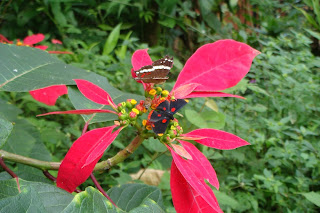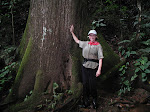It was a full-moon for our last night in New Orleans, and the Mississippi river had nearly crested the levee nearby where we live. To save New Orleans from another devastating flood, the Corps of Engineers had just opened the Morganza Spillway upriver, flooding thousands of acres and causing much heartbreak. We left the next day for Costa Rica – coming home to a waning moon.
And there is no more important waning moon in Costa Rica than the ‘Menguante de Mayo’ – when we all rush to plant and prune as the first rains of the season begin.
And, Oh, the joy of farm-living; we came home to the Finca, finding abundant fruit – citrus, mangos, granadillas, pitanga, papayas, bananas, manzana de agua, capulin berries, and still more coming – all of it just so delicious! The air is fragrant with orange blossoms!
And what a bumper crop of mangos we’re harvesting this year - the best ever since Armando pruned and fussed with the trees. You have to pick mangos at just the right time, before the fruit gets too soft, box them up with newspaper, and then - get out them recipes! So far, we’ve made mango chutney, mango ice-cream and mango cakes; we’re sharing mangos with everybody in the neighborhood - even though everybody has their own mangos this time of year; and we’re even thinking of freezing some for the off-season… And, if that’s not enough, the unripe, sour criollo mangos are also ready – perfect for a tropical mango salad!

It has definitely started raining here – although quite late in the month for us - so we are very busy planting and pruning. After several years of living in the forest, I have come to cherish the small spaces of sunlight, not just for powering our solar panels but also for the gardens. Basically, we have allowed native, forest species to take over the ornamental gardens, and all the other sunny spots have been snagged for the edibles. Where there is sun and a source of water, we will grow edibles. In general, it makes more economic sense to go to the local organic markets to purchase your food. But there is no greater pleasure - and no better tasting food - than to grow your own! The big secret, besides finding the right sunny, well drained spot, is the soil. We’ve learned a lot about composting in the Tropics. It goes without saying that the horses, cows and chickens have done much to enrich the soil… And now, as we enter the rainy season with fewer sunny hours, we hasten to harvest the tomatoes before they succumb to too much rain and not enough sun. We have recently planted smaller varieties hoping that they ripen faster. Experiment, experiment, experiment…
The start of the rainy season also means fewer sun-hours for our solar panels. We have discovered that the key to solar-living is attentive maintenance and flexibility in the consumption of power. Also, we have all had to learn a smattering of electrical engineering just to live with the system. It took a few bumpy years of too many hours of needed generator back-up, before understanding how to live comfortably and efficiently with solar power. For example, when the generator came on in the middle of the sunny dry season, Armando learned that we have to wash the panels regularly to keep off the dust, because it significantly lowers efficiency. But now the daily rain will help with that task, although there is obviously less sun during the day! There’s always some issue to think about, and then deal with, when you’re living ‘off the grid’…
 |
| Geovanna and Lucero |
The horses are doing very well indeed at the moment. We watched them today, feasting on grasses growing in the pastureland below the house. However, the biting-fly season is starting early this year! Luckily though, we have found that more flies pester us on the opposite side of the mountain, when we go out riding near the rivers; so far, there are not that many flies up in the pastures on our side – yet! We have been trying for years to reduce the pesky insect populations – cleaning drains, composting manure, treating the animals - and we had great success last year. This season could be difficult, however, because we don’t usually see many biting-flies anywhere until around July - and it’s only May! It goes without saying that we’re experimenting with herbal repellents – they all work but are too short-acting – especially citronella, which works best in mixtures with other herbs. You have to vary the formula frequently to keep confusing the bugs, and not allow them to get used to the scent. They should ideally be fragrant and pleasant to us, but really nasty to the mosquitoes and flies…
I was delighted to read in La Nacion and see on local TV newscasts, that they are re-planting the city park in San Jose, La Sabana, with native species, some of which are coming from the CNFL nursery located at the University for Peace – just up the road from where we live. The forest here in El Rodeo is actually spreading to La Sabana! We are thrilled for the residents of San Jose because these native trees produce berries and flowers that attract many species of birds and other fauna. The Sabana park will become much more like a forest, bringing joy and fascination to all those who appreciate Costa Rican biodiversity. There is no greater comfort to the spirit and body than a walk in a beautiful park. Just the beauty of the nature all around you brings such pleasure, and soon you feel your troubles lifting. Everything becomes possible, do-able. Of course, I’ve sought out parks all my life. No matter what city I have found myself in, and no matter how much stress I have in work or life, I have found solace in the city park. Back in Michigan, parks were everywhere – practically every neighborhood has a park – some with lakes. Now, San Jose will have a park worth visiting, and I am just delighted.
Can you imagine reading such a question on an official, national Census Form: “How do you primarily dispose of your garbage?” And one of the possible answers to check is, “Dump it in a river, a stream or the sea”! Believe it or not, that was a common disposal method in Costa Rica until recently, and now the new Costa Rican Census will quantify, among many other things, how Costa Ricans currently dispose of their garbage. That shows how important the subject has become in this country, when the government wants to try to quantify the problem. And, not only that, Question 17 asks specifically about re-cycling. Why do I write so much about re-cycling? Because we live ‘off the grid’ and have no municipal services at all – including no garbage pick-up. So we have learned to re-use and re-cycle the vast majority of everything we buy. Necessity is the mother of invention!
Since returning to Costa Rica from NOLA, we’ve read several news reports about re-cycling and clean-up efforts. Volunteers began cleaning up rivers last spring, including here in El Rodeo, and the movement has apparently now spread all over the country. What has really impressed me about the Costa Ricans is that they are now not only embracing the concepts of re-using and re-cycling, but also that they want to go out and help make things right. Business opportunities have also consequently grown, as people become aware of the value of re-cycled materials. Here in El Rodeo, the re-cycling company, Servicios Ecologicos, picks up re-cycled materials from households on a regular schedule, now that we have had to remove the community re-cycling bins because too many uninformed people were just dumping unsorted trash, not using the correct bin, or making a mess in general. Every change in this world requires a process of education and lots of patience… The main thing is that we are headed in the right direction. I see much less trash littering the woodland roads now than a few years ago, although we always carry along a bag to pick up crap when we see it. All any of us can do is set an example.

The kids joined Armando and me for a walk this past weekend. Oh, how the kids have grown! We wandered the trails and took a few pictures. Here’s a shot of the group.




































